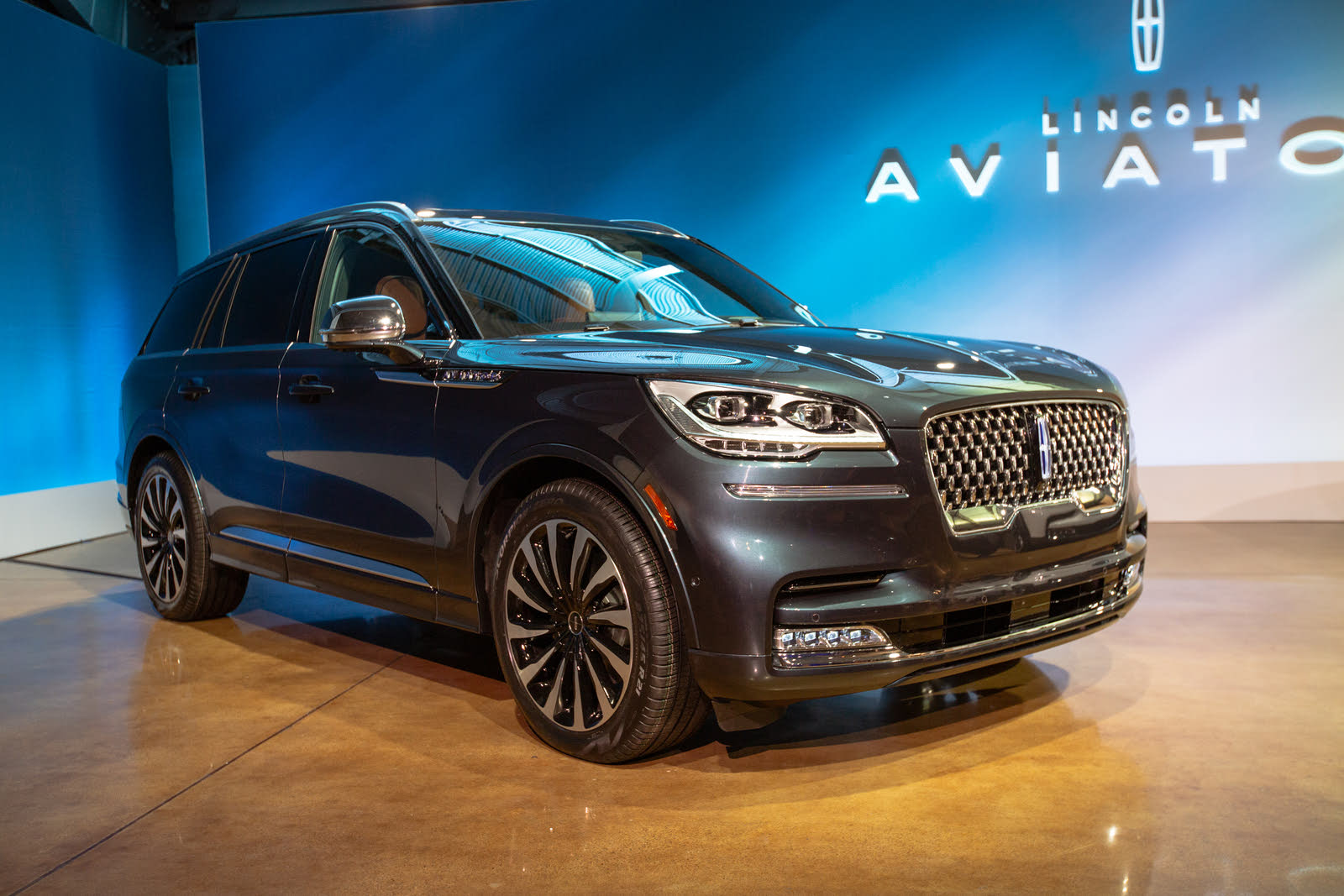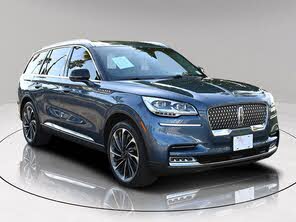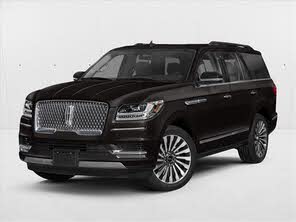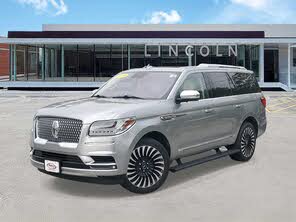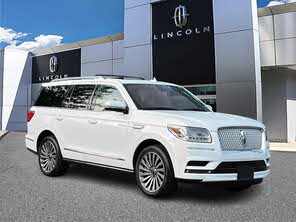2020 Lincoln Aviator vs 2020 Lincoln Navigator
Overview | |
MSRP$51,100 | MSRP$76,185 |
Listings591 | Listings285 |
Ratings & Reviews | |
User Reviews | User Reviews |
Expert reviews8.2 out of 10 | Expert reviews8.2 out of 10 |
Pros
Cons
| Pros
Cons
|
2020 Lincoln Aviator Reviews SummaryThe heyday for Lincoln was more than a half-century ago. Those postwar years of prosperity and optimism were the perfect time for cars like the Continental and others. They delivered comfort and luxury, wrapped in midcentury modern styling. Even as recently as the 1990s, Lincoln was still a popular brand, riding the SUV craze with its Navigator. But after the turn of the century, Lincoln lost its ability to create new designs and looked inward and backward. Sure, retro-themed cars like the redesigned Mustang, PT Cruiser, and Chevy HHR had turned some heads, but none of those came from luxury brands. The BMWs and Mercedes of the world were all looking forward and pushing the envelope for contemporary automotive design. Meanwhile, Lincoln offered the MKX, which was based on the Ford Edge and featured ’66 Continental styling. Neat in a vacuum, but off-base compared to the modern luxury market. This experimental phase with various retro looks coincided with the move to the MK-# alphabet-soup naming convention and big improvements in the Ford lineup, where top-end trims of the Fusion overlapped with an entry-level trim of the MKZ. The combination left Lincoln a confusing, anonymous afterthought in the modern luxury game. But Lincoln is finally ready to change all that. It has a new cohesive design language, its focus is once again on luxury, and the three-letter naming convention that never meant anything to anyone other than Lincoln marketers is gone. The brand led with the 2017 Continental and 2018 Navigator, which are each impressive in their own right. But the company's lineup is growing and now includes the all-new 2020 Lincoln Aviator. Named after a luxury variant of the 2002-2005 Ford Explorer, this new Aviator is also based on the contemporary Explorer platform, but it's a luxury vehicle in its own right. Much of the success of the Lincoln brand may hinge on this midsize, 3-row luxury SUV, so you need to consider its competition, such as the Audi Q7, Infiniti QX60, and all-new Cadillac XT6. Read on to learn if Lincoln’s take on luxury will stand out in a crowded competitive field. | |
2020 Lincoln Navigator Reviews SummaryFrom an impressive customer care program to a lineup of luxury vehicles focused on catering to and coddling its clients, Lincoln is carving a niche for itself in a space the automaker has referred to as “quiet luxury.” With the discontinuation of both the Continental and MKZ sedans after the 2020 model year, Lincoln will now rely on a lineup of four SUVs to continue its quest for success. Of those SUVs, the 2020 Lincoln Navigator is the flagship setting the course for the future. | |
No video found | |
Popular Features & Specs | |
Engine3.0L 400 hp V6 | Engine3.5L 450 hp V6 |
Drive TrainRWD | Drive Train4X2 |
Seating Capacity7 | Seating Capacity8 |
Horsepower | Horsepower450 hp @ 5500 rpm |
MPG City18 | MPG City16 |
MPG Highway26 | MPG Highway22 |
Engine | |
Engine Name3.0L 400 hp V6 | Engine Name3.5L 450 hp V6 |
Torque | Torque510 lb-ft @ 3000 rpm |
Horsepower | Horsepower450 hp @ 5500 rpm |
DrivetrainRWD | Drivetrain4X2 |
Fuel Economy | |
MPG City18 | MPG City16 |
MPG Highway26 | MPG Highway22 |
Interior | |
Leather Seats | Leather SeatsStandard |
Seating Capacity7 | Seating Capacity8 |
Key Features | |
Navigation System | Navigation SystemStandard |
Safety | |
Front Crash Overall5 | Front Crash Overall5 |
Side Crash Overall5 | Side Crash Overall5 |
Dimensions & Capacity | |
Cargo Space18.3 cu ft | Cargo Space20.9 cu ft |
Curb Weight4764 lbs | Curb Weight5673 lbs |
Height69.8 in | Height76.4 in |
Length199.3 in | Length210.0 in |
Width89.9 in | Width93.8 in |
Wheelbase119.1 in | Wheelbase122.5 in |
Maximum Payload | Maximum Payload1620 lbs |
Number of doors4 | Number of doors4 |
Maximum Towing Capacity | Maximum Towing Capacity8600 lbs |
Standard Towing Capacity | Standard Towing Capacity6200 lbs |
Overview | ||
MSRP | $51,100 | $76,185 |
Listings | ||
Ratings & Reviews | ||
User reviews | ||
Expert reviews | 8.2 out of 10Read full review | 8.2 out of 10Read full review |
Pros & cons | Pros
Cons
| Pros
Cons
|
Summary | The heyday for Lincoln was more than a half-century ago. Those postwar years of prosperity and optimism were the perfect time for cars like the Continental and others. They delivered comfort and luxury, wrapped in midcentury modern styling. Even as recently as the 1990s, Lincoln was still a popular brand, riding the SUV craze with its Navigator. But after the turn of the century, Lincoln lost its ability to create new designs and looked inward and backward. Sure, retro-themed cars like the redesigned Mustang, PT Cruiser, and Chevy HHR had turned some heads, but none of those came from luxury brands. The BMWs and Mercedes of the world were all looking forward and pushing the envelope for contemporary automotive design. Meanwhile, Lincoln offered the MKX, which was based on the Ford Edge and featured ’66 Continental styling. Neat in a vacuum, but off-base compared to the modern luxury market. This experimental phase with various retro looks coincided with the move to the MK-# alphabet-soup naming convention and big improvements in the Ford lineup, where top-end trims of the Fusion overlapped with an entry-level trim of the MKZ. The combination left Lincoln a confusing, anonymous afterthought in the modern luxury game. But Lincoln is finally ready to change all that. It has a new cohesive design language, its focus is once again on luxury, and the three-letter naming convention that never meant anything to anyone other than Lincoln marketers is gone. The brand led with the 2017 Continental and 2018 Navigator, which are each impressive in their own right. But the company's lineup is growing and now includes the all-new 2020 Lincoln Aviator. Named after a luxury variant of the 2002-2005 Ford Explorer, this new Aviator is also based on the contemporary Explorer platform, but it's a luxury vehicle in its own right. Much of the success of the Lincoln brand may hinge on this midsize, 3-row luxury SUV, so you need to consider its competition, such as the Audi Q7, Infiniti QX60, and all-new Cadillac XT6. Read on to learn if Lincoln’s take on luxury will stand out in a crowded competitive field. | From an impressive customer care program to a lineup of luxury vehicles focused on catering to and coddling its clients, Lincoln is carving a niche for itself in a space the automaker has referred to as “quiet luxury.” With the discontinuation of both the Continental and MKZ sedans after the 2020 model year, Lincoln will now rely on a lineup of four SUVs to continue its quest for success. Of those SUVs, the 2020 Lincoln Navigator is the flagship setting the course for the future. |
Video | No video found | |
Popular Features & Specs | ||
Engine | 3.0L 400 hp V6 | 3.5L 450 hp V6 |
Drive Train | RWD | 4X2 |
Seating Capacity | 7 | 8 |
Horsepower | 450 hp @ 5500 rpm | |
MPG City | 18 | 16 |
MPG Highway | 26 | 22 |
Engine | ||
Engine Name | 3.0L 400 hp V6 | 3.5L 450 hp V6 |
Torque | 510 lb-ft @ 3000 rpm | |
Horsepower | 450 hp @ 5500 rpm | |
Drivetrain | RWD | 4X2 |
Fuel Economy | ||
MPG City | 18 | 16 |
MPG Highway | 26 | 22 |
Interior | ||
Leather Seats | Standard | |
Seating Capacity | 7 | 8 |
Key Features | ||
Navigation System | Standard | |
Safety | ||
Front Crash Overall | 5 | 5 |
Side Crash Overall | 5 | 5 |
Dimensions & Capacity | ||
Cargo Space | 18.3 cu ft | 20.9 cu ft |
Curb Weight | 4764 lbs | 5673 lbs |
Height | 69.8 in | 76.4 in |
Length | 199.3 in | 210.0 in |
Width | 89.9 in | 93.8 in |
Wheelbase | 119.1 in | 122.5 in |
Maximum Payload | 1620 lbs | |
Number of doors | 4 | 4 |
Maximum Towing Capacity | 8600 lbs | |
Standard Towing Capacity | 6200 lbs | |
The 2020 Lincoln Aviator slotted below the Navigator and above the compact MKC and its replacement, the Lincoln Corsair, in Lincoln's lineup. The Aviator featured a unified design language across Lincoln's sedans, crossovers, and SUVs, with handsome headlights and an upright chrome grille. Its roofline tapered slightly, giving it an elongated look, while the low, wide beltline provided a boat-like appearance. Inside, the Aviator's cabin boasted a flowing design with soft-touch materials and selective use of brightwork. The seats were both elegant and sturdy, with shifter buttons resembling piano keys. The Aviator's interior was plush, with soft-touch materials extending to the dash, door panels, and even the sides of the center console. Notable features included a massive panoramic moonroof and unique warning jingles recorded by the Detroit Symphony Orchestra.
The 2020 Lincoln Navigator, sharing a platform with the Ford Expedition, distinguished itself with unique front and rear styling elements and the Lincoln Embrace lighting system. The Navigator featured a lattice-type grille insert, illuminated star logo, fender vents, and full-width taillights. The Reserve Monochromatic Package added a custom look with body-color grille and side mirror enhancements, and 22-inch black-painted wheels. The Navigator offered standard, Reserve, and Black Label trims, with options for standard-wheelbase and long-wheelbase Navigator L body styles, and rear-wheel drive (RWD) or four-wheel drive (4WD). The test vehicle, a standard-length Navigator Reserve with 4WD, featured Dark Slate leather interior, 30-way Perfect Position front seats, digital instrumentation, a 10-inch infotainment touchscreen, and piano-key transmission controls. The panoramic glass roof and high-quality materials added to the luxurious feel.




The 2020 Lincoln Aviator came standard with a twin-turbocharged 3.0-liter V6 engine producing 400 horsepower and 415 lb-ft of torque. The Grand Touring trim combined this engine with a 100-hp electric motor, resulting in a net 494 hp and 630 lb-ft of torque. Both powertrains used a 10-speed automatic transmission, with the base V6 offering RWD or AWD, and the plug-in hybrid (PHEV) being AWD. Both versions could accelerate from 0-60 mph in about 4 seconds. The Grand Touring's hybrid setup provided smooth, confident acceleration and improved fuel efficiency, with a combined 23 mpg, a 21-mile electric-only range, and a 56 miles-per-gallon equivalent combined rating. The Aviator's steering was light, and its brakes were cushioned, offering a refined driving experience. Fuel economy for the conventionally powered Aviator with RWD was 18 mpg city, 26 highway, and 21 combined, while AWD models achieved 17 mpg city, 24 highway, and 20 combined.
The 2020 Lincoln Navigator featured a twin-turbocharged 3.5-liter V6 engine generating 450 horsepower and 510 lb-ft of torque, paired with a 10-speed automatic transmission. The Navigator offered multiple Lincoln Drive Modes, including Conserve, Normal, Excite, Slippery, Deep Conditions, and Slow Climb (with the optional towing package). The maximum towing capacity was 8,700 pounds with RWD and 8,300 pounds with 4WD, aided by Pro Trailer Backup Assist. The Navigator's acceleration was strong, with a subtle engine note. However, fuel economy was a concern, averaging 16.4 mpg on the testing loop, with an EPA rating of 18 mpg combined. The Navigator's adaptive damping suspension struggled with impact harshness on imperfect pavement, especially in Excite mode, but body motion control was excellent. The Navigator felt huge around town, but a tight turning radius, parking assist system, and numerous camera views improved maneuverability.
The 2020 Lincoln Aviator, with its three rows, competed with the Audi Q7, Infiniti QX60, Mercedes-Benz GLE, Land Rover Discovery, and Cadillac XT6. The optional second-row captain’s chairs were fantastic, while the power-closing third row was adequate for adults but best suited for kids on longer trips. Dropping the second and third rows provided 77 cubic feet of cargo space, comparable to the Cadillac XT6. The Aviator's seats and door handles were somewhat confusing, with seat controls split between a door-mounted panel and a center touchscreen menu. The door-release function was also unconventional, with a button instead of a handle, which could be problematic in certain situations.
The 2020 Lincoln Navigator required climbing up into the SUV, but once inside, passengers found plenty of room to stretch out. The test vehicle's 30-way Perfect Position front seats were exceptionally comfortable, with power-adjustable pedals and a heated steering wheel. The second row offered a choice between a three-person bench or captain’s chairs with a large center console and audio system controls. The Navigator's third-row seat provided excellent legroom and thigh support, unmatched by competitors. Cargo volumes were class-leading, with the standard-length model offering 19.3 cubic feet behind the third row, 57.5 cubic feet behind the second row, and 103.3 cubic feet maximum. The longer Navigator L increased these measurements to 34.3, 73.3, and 120.2 cubic feet, respectively.
The 2020 Lincoln Aviator came standard with the Sync 3 infotainment system, operated via a 10.1-inch touchscreen. The screen used a landscape layout, providing a better interface for Apple CarPlay and Android Auto. The Aviator also featured a fully digital instrument panel and a massive head-up display, offering a lot of information in a minimalist and unobtrusive manner.
The 2020 Lincoln Navigator's Sync 3 infotainment system was less impressive, taking time to load content. However, it provided Apple CarPlay, Android Auto, Lincoln Connect services with a 4G LTE WiFi hotspot, 911 Assist, a Lincoln Way smartphone and smartwatch app, and wireless device charging. "Phone As A Key" technology allowed the smartphone to function as the vehicle key. The voice recognition system worked reasonably well but was not as advanced as some competitors. The Reserve’s Luxury Package included a 20-speaker Revel Ultima audio system with three listening profiles. Additional technologies included a surround-view camera system and a head-up display, with an optional Lincoln Play rear-seat entertainment system.
The 2020 Lincoln Aviator came standard with a full array of front and side-impact airbags, traction control, and a tire pressure monitoring system. The Lincoln Co-Pilot360 suite included forward-collision avoidance, lane-departure warning, adaptive cruise control, automatic high beams, blind-spot monitoring, and a head-up display.
The 2020 Lincoln Navigator featured the Lincoln Co-Pilot360 collection of advanced driving assistance systems (ADAS), including forward-collision warning with pedestrian detection, automatic emergency braking, lane-departure warning with lane-keeping assistance, a blind-spot warning system with trailer coverage, a rear cross-traffic warning system, and automatic high-beam headlights. The Reserve trim added adaptive cruise control with stop-and-go capability. The Navigator's adaptive cruise control and lane-keeping assistance operated with refinement. The Navigator received a five-star overall safety rating from the National Highway Traffic Safety Administration (NHTSA), but the RWD model had a three-star rollover resistance rating. The Insurance Institute for Highway Safety (IIHS) had not tested the 2020 model.
CarGurus highlights
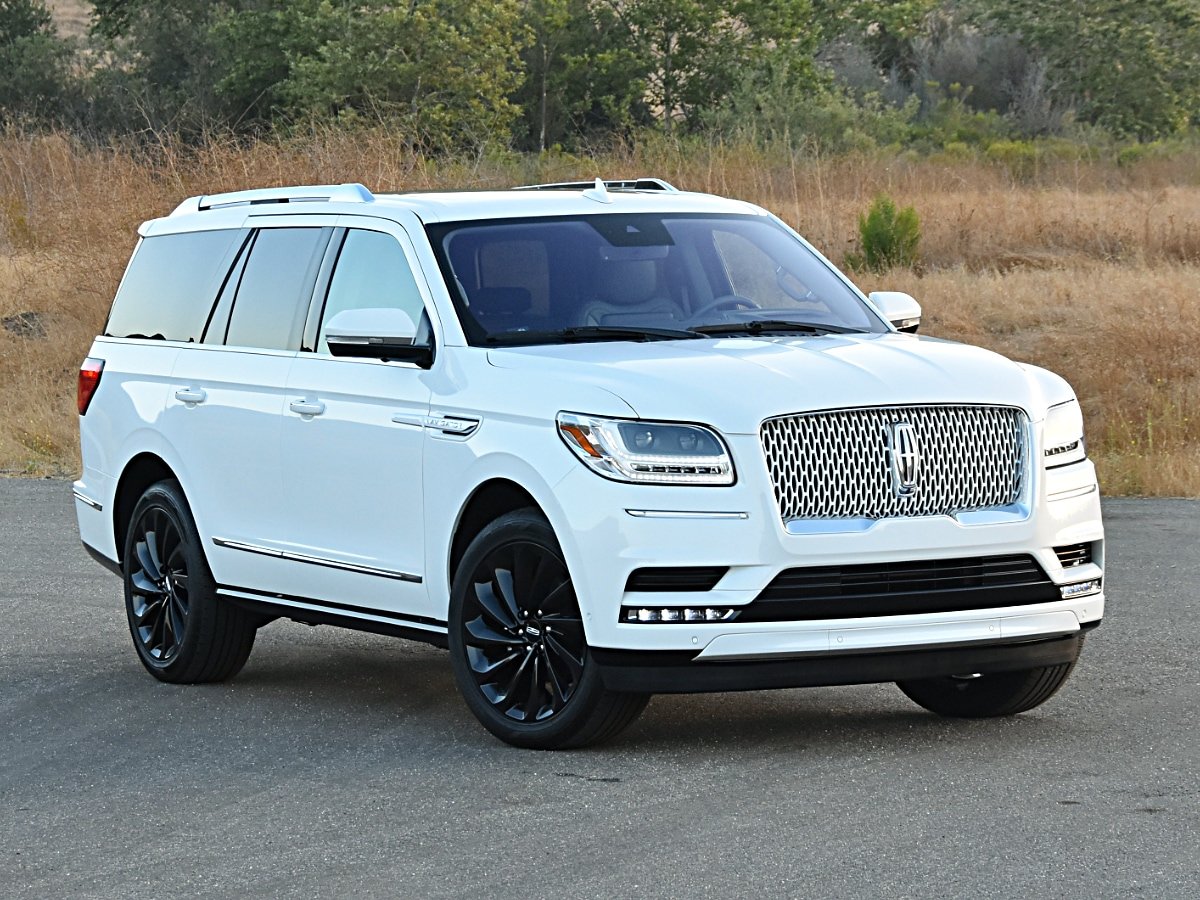
According to CarGurus experts, the overall rating for the 2020 Lincoln Aviator is 8.2 out of 10, while the 2020 Lincoln Navigator scores 8.2 out of 10. Both vehicles offer impressive luxury and performance, but the Navigator's larger size, greater towing capacity, and superior passenger comfort make it the better choice for those needing more space and power.
Choose the 2020 Lincoln Aviator if:
- You prefer a more compact and agile luxury SUV.
- You value a plug-in hybrid option for better fuel efficiency.
- You appreciate unique luxury touches like orchestral warning jingles.
Choose the 2020 Lincoln Navigator if:
- You need a larger SUV with class-leading passenger and cargo space.
- You require a higher towing capacity for trailers or boats.
- You want a more powerful engine with advanced towing assistance features.
CarGurus highlights

According to CarGurus experts, the overall rating for the 2020 Lincoln Aviator is 8.2 out of 10, while the 2020 Lincoln Navigator scores 8.2 out of 10. Both vehicles offer impressive luxury and performance, but the Navigator's larger size, greater towing capacity, and superior passenger comfort make it the better choice for those needing more space and power.
Choose the 2020 Lincoln Aviator if:
Shop Now- You prefer a more compact and agile luxury SUV.
- You value a plug-in hybrid option for better fuel efficiency.
- You appreciate unique luxury touches like orchestral warning jingles.
Choose the 2020 Lincoln Navigator if:
Shop Now- You need a larger SUV with class-leading passenger and cargo space.
- You require a higher towing capacity for trailers or boats.
- You want a more powerful engine with advanced towing assistance features.

By: CarGurus + AI
At CarGurus, our team of experienced automotive writers remain at the heart of our content operation, conducting hands-on car tests and writing insightful guides that are backed by years of industry experience. To complement this, we are harnessing AI to make our content offering more diverse and more helpful to shoppers than ever. To achieve this, our AI systems are based exclusively on CarGurus content, ratings and data, so that what we produce is both unique to CarGurus, and uniquely helpful to car shoppers.
